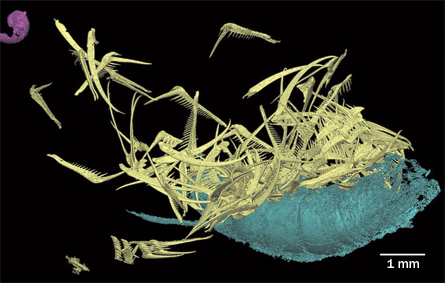An ammonite’s last supper
X-ray image of fossil reveals diet of ancient marine animal
- More than 2 years ago
The final meal of an ammonite, one of those extinct marine creatures that feature so prominently at fossil shows, has been revealed by a three-dimensional X-ray analysis of a specimen from South Dakota. The pointy yellow things are the ammonite’s teeth, stripped off a structure called a radula that acts like a tongue to get prey into the animal’s mouth. The teal-colored blob at lower right is the remains of a small shrimplike crustacean, while the purple thing at upper left is a fragment of a larval gastropod.

Finding these dinner fragments within the ammonite’s mouth strongly suggests that it ate small prey floating in the water, a team led by Isabelle Kruta reports in the Jan. 7 Science. Kruta, of France’s national natural history museum, and her colleagues made images of ammonite fossils at the powerful European Synchrotron Radiation Facility in Grenoble, France.
This particular specimen, of the genus Baculites, dates to between 70 and 83 million years ago. Ammonites thrived for about 340 million years before going extinct 65 million years ago along with the dinosaurs. Kruta and her team speculate that diet may have played a role: when many groups of plankton and associated small animals died out, the ammonites no longer had enough to eat. In contrast, the related cephalopod known as the nautilus survived the extinction, perhaps because it can eat larger prey and a wider variety of food.







